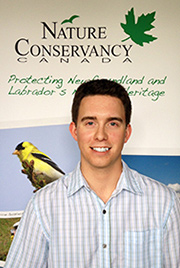Rediscovering Newfoundland
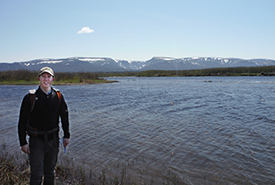
Brandon Ward posing for a picture while performing forest ecological classification (FEC) on the Grand Codroy Estuary (Photo by NCCl)
To say I was excited to land the position as a Nature Conservancy of Canada (NCC) conservation intern for the summer of 2014 would be an understatement. In fact, when I got the call offering me the job, I could hardly resist bursting into smiles and laughter. I was ready to embark on a four-month position with an organization I had been dreaming of working for since developing a strong conservation ethic in my university years.
I have always said that a job that would allow me to contribute to conservation, coupled with regular field work and visiting new exciting places, would be ideal. I swore to myself that I would cherish every second of it and have a summer of “firsts,” creating some great memories for years to come.
Growing up in Newfoundland, I travelled often for sports and summer vacations, but I have always felt that I have never truly “been” anywhere in this beautiful province. I rarely had the opportunity to get out into the natural settings of the seemingly wild areas of Newfoundland, such as the central and western parts of the island. As a kid growing up in a rural fishing community I would play in the woods all day, but now it was time to experience my home province through a different lens.
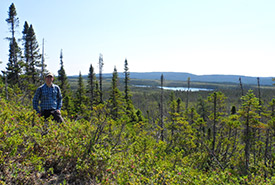
NCC intern Brandon Ward looking out over the peatland (Photo by NCC)
So although I had traversed the island before, making my way to Newfoundland’s Codroy Valley for field work and to host NCC’s Conservation Volunteers events was going to be a novel and exciting experience.
My first trip to the Codroy Valley
After a nine-hour drive from St. John’s to the Codroy Valley with NCC Newfoundland and Labrador staff members Megan Lafferty (NL stewardship coordinator) and Lanna Campbell (NL program manager), we arrived at the Codroy Valley Cottages in Doyles.
Walking up to the cottage I’d be bunking in, I was awestruck by the beautiful landscape before me. The deep blue estuary, the lush green fields and forest set against a backdrop of snow-capped mountains reminded me of Scotland’s Cairngorms, on which I had recently written a research paper. I could not help thinking: some of the first settlers, many of whom were of Scottish decent that left their homes in Cape Breton to eke out a living here, must have felt completely at home in this landscape. I felt a sense of calmness and peace and slept soundly that night, ready to rise early and face the next day’s fieldwork.
Out in the field
The next two days of property monitoring began and we were blessed with sunshine and a gentle breeze — just enough to keep the blackflies and mosquitoes at bay. Trudging through bogs, twisting and turning through dense forests and scrambling over thick stands of shrub and tuckamore (or as we called it back home: “browse”) was an experience in itself. But however tough it was being stabbed by pointed sticks and whipped by branches, the enthusiasm of our group never waned.
I learned much from my colleagues Megan and Lanna, who had great knowledge of all the trees, shrubs, herbs, ferns and mosses found throughout the Newfoundland coniferous forest. My experience working in the Eastern Hyper-Oceanic Barrens ecoregion back home helped with identifying the heath-type vegetation in the shrub bogs. We also took the time to practice our birdsong identification skills, documenting any species we heard and confirming their identity with the birding app on Megan’s mobile device.
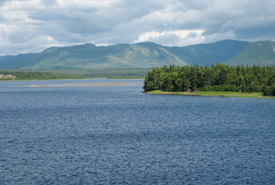
Codroy Valley, Newfoundland and Labrador (Photo by Heather Chaffey)
There is something to be said about experiencing the physical demands of struggling through the forests and bogs: it not only gives you a great appreciation for the ecological complexity of the region, but also for the resilience of fauna that call it home. As I sat on the deck of the cottage in the evenings and ran over each day’s events in my head, I thought of how privileged I was to be there at that moment, watching a flock of mergansers slowly drifting on the still waters of the estuary. The only word to describe it: perfection!
A successful Conservation Volunteers event
The Conservation Volunteers event we hosted in the Codroy Valley was nothing short of a success. I assisted Megan in presenting to 50 students from Grades 1 to 4 of the local elementary school. Facilitating a great experiential learning opportunity right in their backyards was truly fulfilling. The enthusiasm shown by the kids and their determination to spot and identify birds was uplifting. I was pleased to see the appreciation they showed for their surrounding environment. One could only hope that that appreciation would blossom, creating some of the province’s future conservationists.
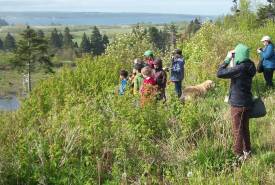
NCC Birding Bonanza Conservation Volunteers event, Grand Codroy Valley, NL (Photo by Tina Newbury)
The highlight of that day for many volunteers, myself included, was catching a glimpse of not one, but three endangered and provincially rare piping plovers on the beach at the mouth of the estuary! It was an experience of a lifetime.
As Megan, Lanna and I left the beach that evening we all felt uncontainable feelings of excitement, awe and accomplishment.
Now I've really been somewhere!
On the drive back to St. John’s, between chatting and laughing, I reminisced on the past week’s events with a feeling of accomplishment for myself and my colleagues. We had contributed to the conservation of some of the most biologically diverse and beautiful wetlands in the province. I felt I had had a truly intimate experience with all of the sights, sounds and smells of the Codroy Valley. I met and chatted with some interesting people and learned a bit about their culture and heritage. And to top it off I felt like finally I had really “been” somewhere in Newfoundland.
Career development
Upon my return home I realized my trip to the Codroy Valley was all I had hoped for and more from a career standpoint. It had allowed me to greatly enhance my technical field skills. My plant identification and forest ecological classification ability improved dramatically thanks to extensive coverage of the Codroy Estuary with very knowledgeable colleagues. My determination and effort to identify as many songbirds by sight and sound, during field work and volunteer events, has improved my birding abilities significantly. These experiences helped build upon my current knowledge of Newfoundland and Canadian boreal ecology and improve my technical abilities to perform future conservation-oriented job tasks.
The social side of our stewardship, such as environmental education and meeting with landowners and stewards, has enhanced my skills in this regard. It is in these real life situations that you learn and grow communication and interpersonal skills, which are of utmost importance to ensure successful conservation endeavours. Technical ability, coupled with intellect and well-developed social skills, is what makes for a great conservationist. I feel privileged to be given the opportunity to develop into a well-rounded conservationist and to contribute to my career aspiration of playing a role in protecting, conserving and promoting natural areas within our province and country, and the world.

